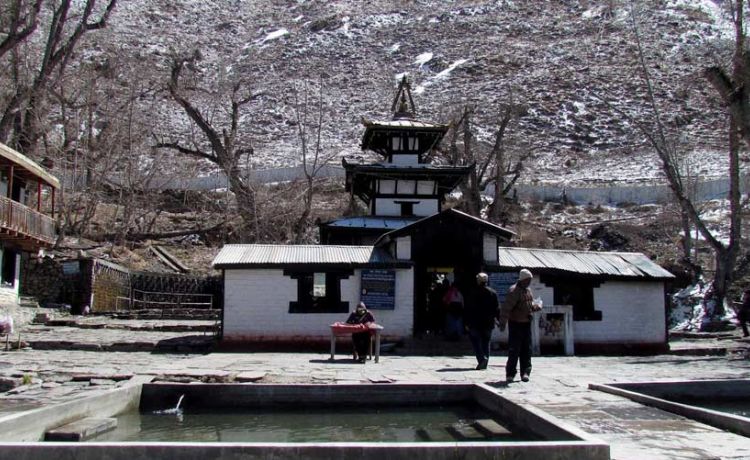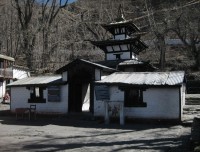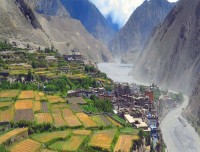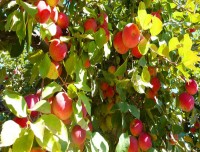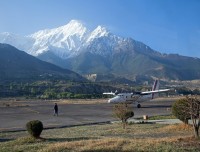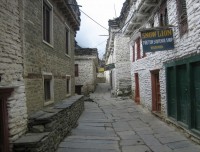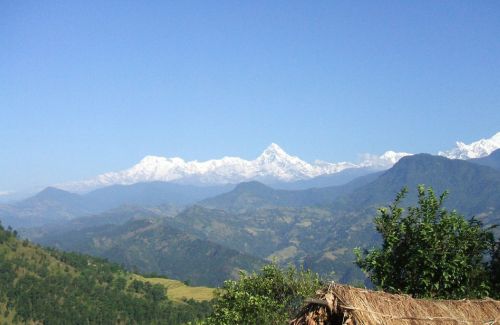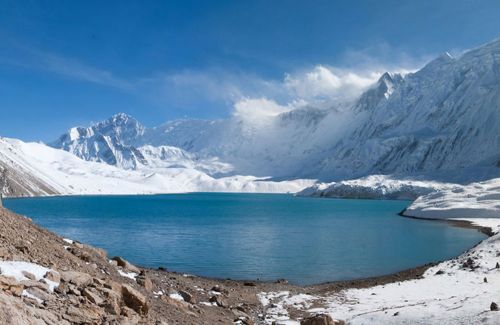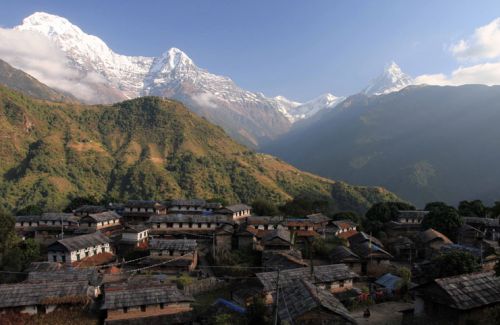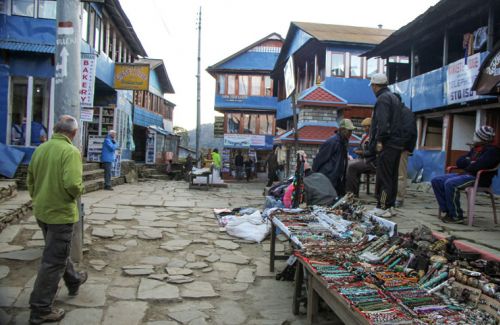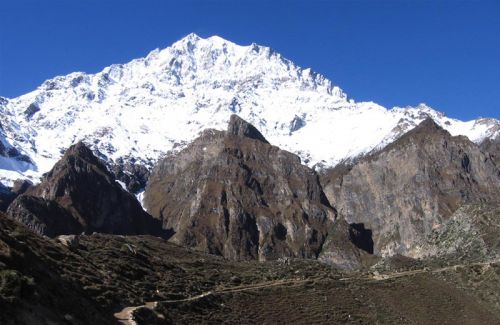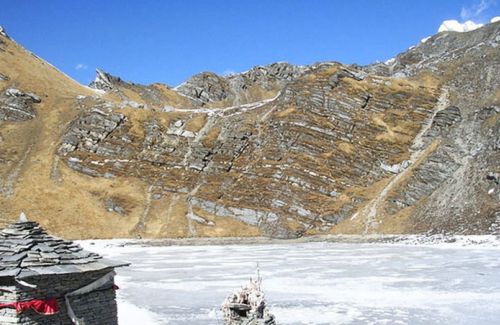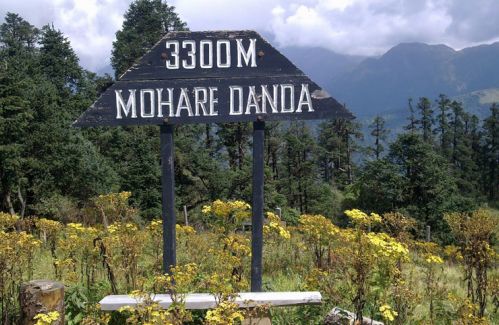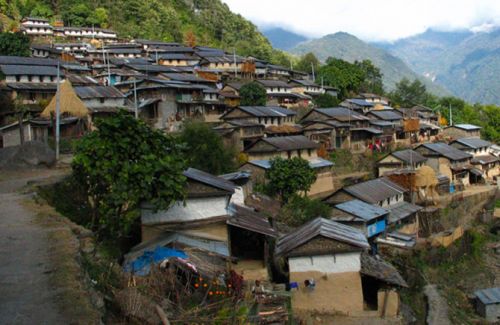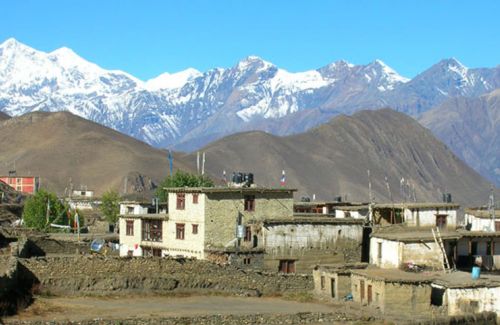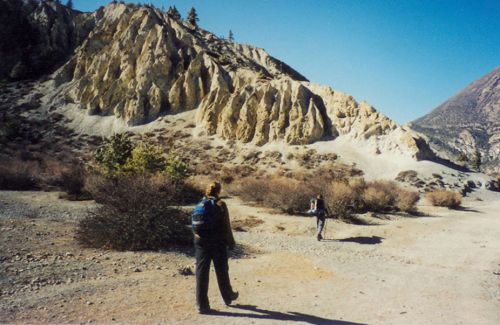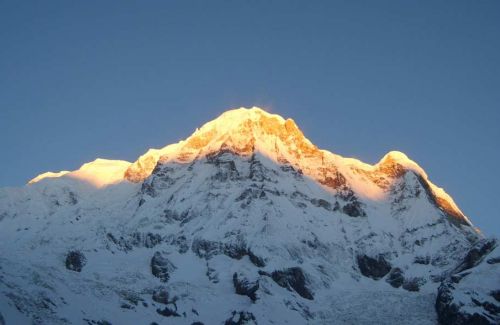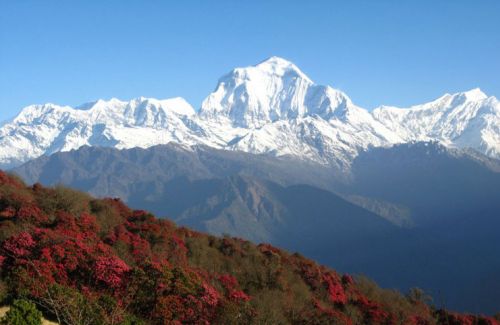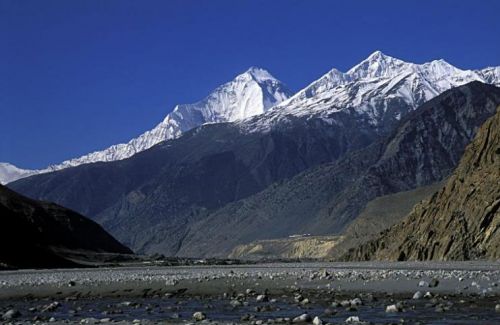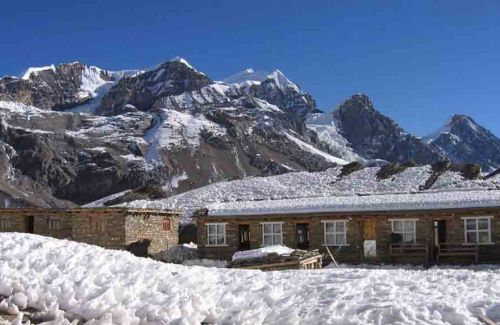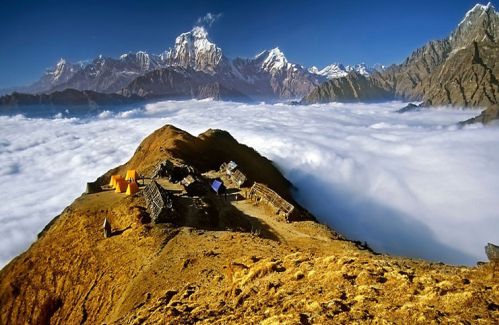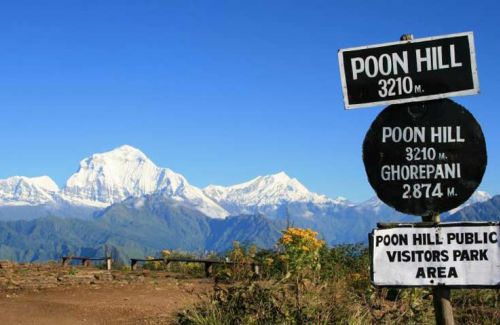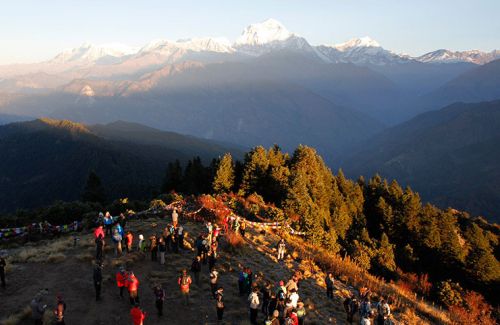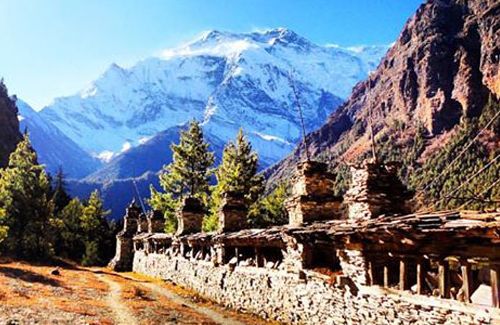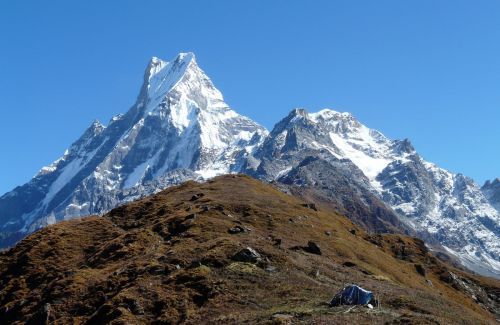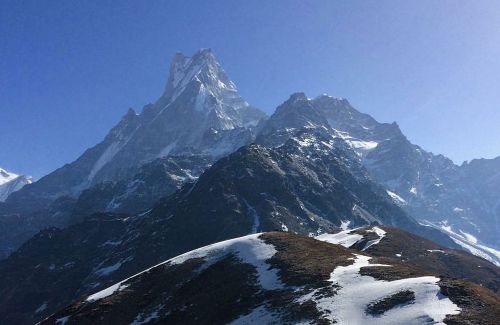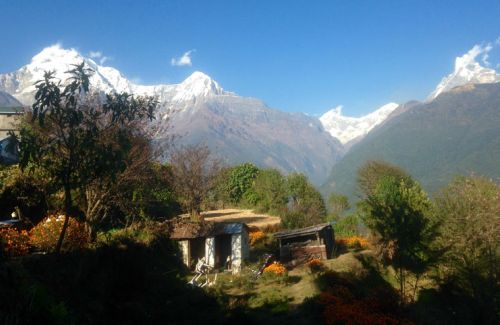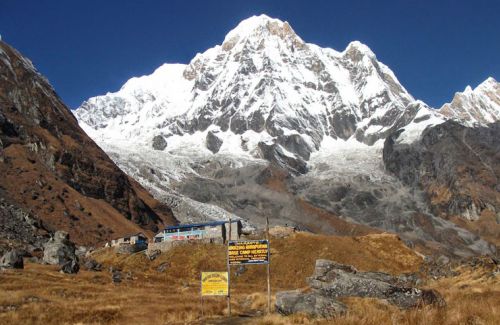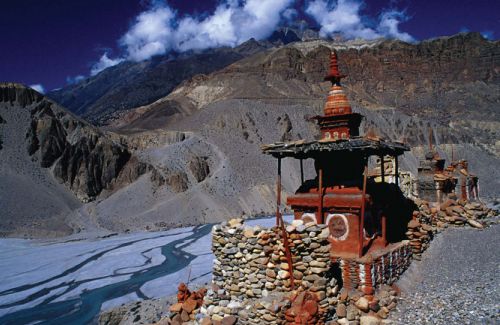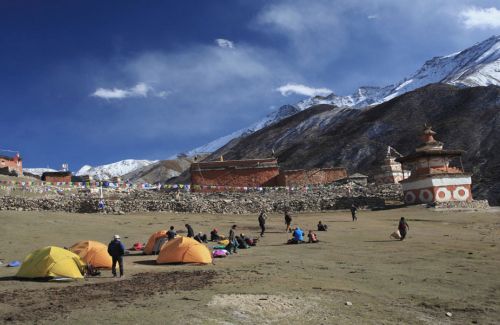Jomsom Muktinath Trekking
- Duration15 Days
- Max. Altitude 3,800 m.
- Starts FromUSD 1285
Destination:Nepal
Trip Grade:Moderate (**)
Meals:Breakfast + Lunch + Dinner
Transportation:Private Vehicle/Tourist Bus
Accommodation:Lodge
Best Season:February to May & September to December
Show AllJomsom Muktinath Trekking is an acknowledged classic, an ideal sampler of Himalayan scenery and culture. Jomsom Muktinath Trek is being done to explore the hundred years old monastery, caves, local tribes and scenic beauty of the different landscapes. This trail has been much more commercialized. Many lodges have electricity and hot showers. The full Jomsom trek takes two weeks but the trail network is extensive.
The Trek Jomsom Muktinath starts from Pokhara, the hub of adventure seeker, then takes one and half an hour drive to Nayapul. This is place from where we leave the pitched road, take well trodden road to Birethanti, Ulleri following stone steps and reach to Ghorepani . Being fresh and active early in the morning, we climb to Poon Hill to enjoy the sunrise. This place is well known for 360 degree magnificent views of Annapurna massifs, Dhaulagiri, Hiuchuli and other mountains.
North of Poon Hill, the trail drops into the valley of the Kaligandaki, locally called Thak Khola. Many different ethnic groups are dwelling in the valley in perfect harmony. Thakalis are the dominant group among them. You could differentiate the natural wonder following the world’s deepest gorge and 8,000 m high Dhaulagiri and Annapurna on the other side. The further you go , the more variations on scenery you find. Tatopani is a place, famous for hot springs and citrus fruit gardens. Many Hindu pilgrims go to take ritual bath there so that they can get rid of sin. There may be the scientific reason that taking bath in hot shower could cure the skin diseases. The trail further passes up to Tukche, once the main Thakali trading center and Marpha, a clean, beautiful village surrounded by apple and apricot orchards, often taken this name while composing Nepali music because of its scenic beauty and the red, fresh apple, compared with the beauty of beloved.
Above Tukche, the vegetation dies out as we begin to enter the Himalayan rain shadow and a sand blowing wind from the south, may change the state of your mind. The trail passes to Jomsom and romantic fortress town of Kagbeni. The Nepali movie “Kagbeni” is in the periphery of this place. Geographically, we are now on the edge of the Tibetan plateau, with the main Himalayan chain looming magnificently. From Ekali Bhatti, the path splits in two ways. The higher path goes to Muktinath and the other one leads to Upper Mustang and Tibet via Kagbeni.
Finally, it’s 1000 m climb up an side valley to poplar- lined Muktinath, located in a popular grove, is a sacred shrine and pilgrimage site for Hindus and Buddhists.We can see the miracle of burning natural gas in a small Buddhist shrine below the main Hindu temple. Hindus named the site “Muktichhetra” meaning “ Place of Salvation." There are 108 water spouts in the shape of boars’ head, dedicated to Vishnu. The Buddhists consider the image of Vishnu as the Bodhisattva because Buddha is the eight incarnation of Vishnu. Padmasambhava, who brought Buddhism to Tibet in the 8th century is believed to have meditated here. His “foot prints” are on a rock in the northwest corner of this sacred place. A Full Moon is an auspicious time to visit Muktinath.On the return journey, if you would like to retrace back through Poon Hill, we can grasp the impressive views following Kali Gandaki river south from Tatopani.
Trip Highlights
- Visiting World Heritage Sites in Kathmandu
- Exciting bus drive from Kathmandu to Pokhara through Prithivi Highway
- Great Mountain view from Poon Hill and Muktinath
- Walking through the deepest gorge at Kali Gandaki Valley
- The hub of Adventure seeker – Pokhara Valley
- Hypnotizing scenery on the way to Jomsom /Muktinath
- Explore more than hundred years old monasteries, cave etc.
- Hot spring in Tatopani
- Romantic fortress town of Kagbeni
- Spiritual Destination for both Hindus and Buddhists - Muktinath
- Scenic flight from Jomsom to Pokhara
Day to Day Itinerary
Day 01: Arrival in Kathmandu (1,350 m) & Transfer to Hotel. Overnight at Hotel
Day 02:Kathmandu Sightseeing and Trek Preparation. O/N at Hotel
Day 03:Drive from Kathmandu to Pokhara (827 m), 7 hrs. O/N at Hotel
Day 04:An hour drive to Nayapul (1,050 m) and trek to Tikhedhunga (1,575 m), 4 hrs. O/N at Guest House
Day 05:Trek from Tikhedhunga to Ghorepani (2,840 m), 6 hrs. O/N at Guest House
Day 06:Hike up to Poon Hill (3,210 m) early in the morning and trek to Tatopani (1,190 m), 8 hrs. O/N at Guest House
Day 07:Trek from Tatopani to Ghasa (2,110 m), 7 hrs. O/N at Guest House
Day 08:Trek from Ghasa to Tukche (2,590 m), 6 hrs. O/N at Guest House
Day 09:Trek from Tukche to Kagbeni (2,810 m), 5 hrs. O/N at Guest House
Day 10:Trek from Kagbeni to Muktinath (3,710 m), 5-6 hrs. O/N at Guest House
Day 11:Day Rest at Muktinath - explore around Muktinath Temple premises
Day 12:Trek from Muktinath to Jomsom (2,715 m), 5-6 hrs. O/N at Guest House
Day 13:Fly from Jomsom to Pokhara (827 m), 25 min. O/N at Hotel
Day 14:Drive from Pokhara to Kathmandu, 7 hrs. O/N at Hotel
Day 15:Departure to the International Airport
Cost Include
- Airport Picks up and Drops off by tourist vehicle
- 3 nights in Kathmandu and 2 nights in Pokhara - twin sharing basis accommodation with breakfast
- Guided City tour with private tourist vehicle
- A government licensed holder city tour guide
- Drive from Kathmandu - Pokhara - Kathmandu by Tourist Coach
- Full Board Meal (Breakfast + Lunch + Dinner) during the trek
- Lodges, Guest House basis accomodation during the trek
- Professional English speaking Trekking Guide
- The required number of trekking staffs and Porter (2 Trekkers = 1 Porter)
- Annapurna Conservation Area Entry permit
- TIMS (Trekker’s Information Management System) Fee
- Food, Salary, Accommodation and Insurance of Guide and Porters
- Airfare from Jomsom to Pokhara
- Down Jacket, Duffel Bag and Sleeping Bag by Himkala Adventure if required
- Farewell Dinner with Nepalese cultural show
- Necessary Government Taxes, VAT, and Service Charge
Cost Exclude
- Lunch and Dinner in Kathmandu and in Pokhara
- Entrance fees in heritage sites and other places
- Personal Expenses ( Phone Bills, Bottled or Boiled water, Bar, Laundry, Shower etc.)
- Personal Trekking Equipment
- Nepal Entry Visa Fee
- Your Travel Insurance
- Emergency Rescue Evacuation
- Tips to the Trekking/Tour Staffs and Driver (Tipping is expected)
- Any other expenses that has not been mentioned in the Cost Includes Section
Detail Itinerary
Day 01 Arrival in Kathmandu (1,350 m) & Transfer to Hotel. Overnight at HotelOur representative from Himkala Adventure will be looking forward to your arrival. After the completion of custom formalities, when you arrive at the entrance, you will be warmly greeted and transferred to the hotel at Thamel. You could get refreshed and walk around the touristic area. Overnight at Kathmandu
Day 02Kathmandu Sightseeing and Trek Preparation. O/N at Hotel After breakfast at 9 am, we proceed for the guided city tour. We will visit the UNESCO World Heritage Sites where we can see an artistic exposition of graceful temples, elegant palaces; brick-paved courtyards and quaint streets. The wood carving on the roof struts are especially attractive. The stupas are found in peace with monks walking around spinning prayer wheel and chanting “OM MANI PADME HUM”. After this we return back to Hotel and brief you about the itinerary and trek details to Jomsom Muktinath. Overnight at Kathmandu
Day 03Drive from Kathmandu to Pokhara (827 m), 7 hrs. O/N at Hotel The 6-7 hours drive from Kathmandu to Pokhara gives us scenic pleasure of terraced farmland and countryside. Passing many rural settlements, following the Trishuli River and Marshyangdi, we reach to Pokhara. If we fly, it is an interesting flight over the peaks about half an hour. Overnight at Pokhara
Day 04An hour drive to Nayapul (1,050 m) and trek to Tikhedhunga (1,575 m), 4 hrs. O/N at Guest House After breakfast, we drive an hour from Pokhara (827 m) to Nayapul (1,050 m). The trail descends to the Modi Khola, follows its east bank southward a short distance to a suspension bridge and crosses towards Birethanti (1,097 m).After passing two settlements Lamthali and Sudami, we gradually climb up the side of the valley to Hille (1,524 m). After this the next destination is Tikhedhunga. Overnight at Tikhedhunga
Day 05Trek from Tikhedhunga to Ghorepani (2,840 m), 6 hrs. O/N at Guest House The trek from Tikhedhunga to Ghorepani is about 6 hours and full of fun through rhododendron and oak forest. First we reach to Ulleri (2,073 m) and after an hour from Ulleri, the trail goes up, crosses many streams, reaches to Banthanti(2,307 m). The trail finally reaches to Ghorepani (2,840 m) which is 3 hours walk from Ulleri. Overnight at Ghorepani
Day 06Hike up to Poon Hill (3,210 m) early in the morning and trek to Tatopani (1,190 m), 8 hrs. O/N at Guest House We get up early in the morning and set out for the hike to Poon hill where there is a view tower and 267 m higher than the pass on the ridge to the west. Within an hour we reach to Poon hill. It is the best view point for the scintillating view of Dhaulagiri and the Kali Gandaki gorge. After a while we return back to hotel and have breakfast. Then we continue to Thak Khola, descend through rhododendron forest, prickly-leaved oak, to cultivated areas. We pass through the villages of Chitre (2,316 m) and Phalate (2,256 m) before reaching Sikha (1,920 m) 2 hours from the Pass. The great view of South face of Dhaulagiri can be seen while descending and we cross a tributary and some landslides to Ghara (1,692 m) less than hour from Sikha. We continue through the notch and walk down to the south bank of the Ghar Khola. We cross the bridge and reach to Kali Gandaki. We head upstream, cross the Kali Gandaki on a suspension bridge, and go to Tatopani, one and half an hour from Ghara. Overnight at Tatopani
Day 07Trek from Tatopani to Ghasa (2,110 m), 7 hrs. O/N at Guest House Tatopani, a prosperous Thakali town, takes its name ‘hot water’ from the hot springs located along the bank of the river. We head north from Tatopani to Jaltal and note the junction of the Mistri Khola and the Kali Gandaki. We stay on the west bank of Kali Gandaki and pass through Suki Bagar to reach Dana (1,402 m). After Dana, we cross the tributary, the Gatte Khola and climb to Rupse Chhahare, named after the water fall. From the west side of the route, we climb above of Rupse Chhahare to reach Kabre (1,707 m) in less than half an hour. From Kabre, we continue north along the steep Cliffside to where the valley narrows and the cascading river torrent resounds across the canyon walls. Beyond the most impressive narrow section, the trail crosses a boulder-strewn flat and reaches a Chautara where the east-side trail rejoins it a few minutes south of Ghasa (2,040 m). Ghasa is less than 2 hours from Kabre. Overnight at Ghasa
Day 08Trek from Ghasa to Tukche (2,590 m), 6 hrs. O/N at Guest House After breakfast, we leave Ghasa and climb 20 minutes to Kopche Pani and 45 minutes steep climb to Pahiro Tabla then reach to the bridge and the trail junction below Ghasa. Then we reach to Lete (2,469 m). Heading north, we pass through the spread-out village of Lete, which blends into Kalopani (2,530 m).Sunsets from Kalopani and Lete are amazing. After we cross the east bank of Kali Gandaki, the trail passes through Dhampu and Kokethani before crossing a suspension bridge back to the west bank just below Larjung (2,560 m) From Larjung , we head north, cross a tributary, and in a few minutes enter the fascinating town of Khobang (2,560 m). The trail passes through the tunnel. After an hour walk from Khobang, we arrive at Tukche. Overnight at Tukche
Day 09Trek from Tukche to Kagbeni (2,810 m), 5 hrs. O/N at Guest House After having breakfast at Tukche, we go up the hill to the west of the gomba to Dampus Pass. The next town is Marpha (2,667 m),Marpha is popular for the fine sewer system, and apple orchards. We continue upstream, leaving the town through the chorten and cross a tributary, then reach to Syang. After crossing a tributary, we reach to Jomsom (2,713 m) To continue on to Kagbeni, we head northeast on the west side of the Kali Gandaki, we head upstream and arrive at the trail junction of Ekali Bhatti. The left fork continues up the river to Kagbeni in half an hour. Overnight at Kagbeni
Day 10Trek from Kagbeni to Muktinath (3,710 m), 5-6 hrs. O/N at Guest House The trail from Kagbeni to Muktinath retraces back to Ekali Bhatti, crossing the Dzong Khola, heading east through terraces. We continue east, noting the caves on the north side of the valley. We contour above the town of Khingar to Jharkot (3,612 m), an impressive fortress perched on a ridge one and half hour from the trail junction above Kagbeni. We continue climbing and contouring then go to RaniPauwa after 40 minutes from Jharkot. Muktinath can be reached within 10 minutes from RaniPauwa. Overnight at Muktinath
Day 11Day Rest at Muktinath - explore around Muktinath Temple premises Muktinath is the great Hindu-Buddhist pilgrimage center. Hindu named it Muktichhetra, meaning “place of salvation”. This is originally the Vishnu temple. Buddhists worship this as the Buddha,is the 8th incarnation of Vishnu. There are 108 water spouts. The ammonite fossil “Shaligrama” is also worshipped as the form of Vishnu. There is Jwala Mai temple where natural flame can be seen. We can walk around to explore this area. Overnight at Muktinath
Day 12Trek from Muktinath to Jomsom (2,715 m), 5-6 hrs. O/N at Guest House It is easy walk straight down from Muktinath to Jomsom. While walking down to Jomsom, we can visit the monastery in Jharkot. The rich ethnic culture will impress us. After one and half hour, we reach to Ekali Bhatti where we can have lunch. On the way to Jomsom, we can see the majestic view of Thorung peak, Thorung La Pass and the caves of Upper Mustang. Overnight at Jomsom
Day 13Fly from Jomsom to Pokhara (827 m), 25 min. O/N at Hotel After breakfast at Jomsom, we go to Jomsom Airport and fly back to Pokhara. It is 20 minutes flight between the gorge of Annapurna and Dhaulagiri. We go to the hotel first, check in there and after a while go out for the city tour. We can visit Davi’s fall, Gupteshwor cave, Tibetan Refugees Camp etc. Finally, we can enjoy an hour boating at Phewa Lake. Overnight at Pokhara
Day 14Drive from Pokhara to Kathmandu, 7 hrs. O/N at Hotel It is 200 km from Pokhara to Kathmandu and takes about 6-7 hours. The drive is unforgettable through villages, terraced fields and the forested hills above the road. More than that, on the way back to Kathmandu, we follow the river and streams, cross many bridges and junctions. After arrival, we go to hotel to check in and in the evening, we will have dinner together with typical Nepalese Cultural Show. Overnight at Kathmandu
Day 15Departure to the International Airport We transfer you 3 hours before your flight time. You could utilize the rest of the time for buying dainty gifts to your family members, friends and relatives. Finally, with profuse of thanks, joining Himkala Adventure for the Jomsom- Muktinath Trek, we separate from the Airport. The moment lasts forever. Namaste with palms together!!!
Trip FAQ
Himkala Adventure would like to quench the thirst of all necessary questions answers about Jomsom Muktinath Trekking for all curious travelers/trekkers in the world. As you are entirely from different geographical location, you could better to know everything about the treks from the beginning i.e. airport pick up till your departure like airport picks up, drops off, accommodation in city, in the trek, guide and porters, safety for the trekking, food and accommodation and some other things that you might face on the way. Hope our endeavor listing these questions answers will help you self informed.
This is simply the outlines of the services we offer but it may differ as per your requirement, number of trekkers. What we go through our conversation, we will manage the means of transportation, hotels in the city, accommodation in the trekking, numbers of porters etc. This is general idea about Jomsom Muktinath trekking before your trip and you become clearer about the trek. Please feel free to contact us to get more information about the trekking in the Himalayas of Nepal.
1) How is Jomsom Muktinath Trekking in Nepal?
Jomsom Muktinath Trekking is the popular trekking trail of Annapurna Region in the western part of Nepal.The trek reaches up to3800 m from the sea level. It is a moderate trek and can be done by anyone.The trail traverses along the Kali Gandaki River Gorge and it offers the magnificent mountain views Annapurna-I and Dhaulagiri. We can explore hundreds of years old monastery, caves, local tribes and scenic beauties of the different landscapes.
2) What physical fitness do I need to book this trip?
Every trekking in the Himalayas of Nepal require the certain level of physical and mental fitness.So, we advise you to be in good physical shape and able to feel comfortable while hiking up and down 7 to 12 miles per day on a trail carrying a day pack of about 10 pounds. Three things could make you confident enough for any trek you would like to do: aerobic, strength and mental.
Aerobic conditioning is important primarily because you will be trekking in thinner air, up to 40% less than at sea level. With good aerobic conditioning, you will be able to better metabolize whatever oxygen is available to you. You should plan on doing at least one hour of aerobic 3 /4 times per week for 1 month or more before your arrival in Nepal. Walking, jogging, cycling, hiking on valley floor to ridge line ascents with day back are some of the excellent forms of exercise, so long as you are strengthening leg muscles and building stamina. Speed is not the essence; stamina, confidence and continuity are.
3) How do I find Himkala Adventure for my pick up at the airport?
Our representative from Himkala Adventure will display a small board of company or your name on the sheet of paper outside the airport terminal. You will be driven to the hotel by our tourist vehicle.
4) What sort of accommodation do I get in Kathmandu and Pokhara ?
Normally we provide standard rooms with twin sharing accommodations at three star or similar category hotels in Kathmandu and Pokhara including breakfast. Accommodation in these cities can be upgraded as per your request. But some of our packages are sold without accommodation in the city.
5) How are tea house facilities during Jomsom MuktinathTrekking?
Tea House is the combination of guest house, restaurant, and social hang out. Tea houses in Jomsom Muktinath Trekking area are highly professional though they are simple but with neat and clean lodging offering fine views and plain but fresh and hygienic food with friendly atmosphere Most of the Tea Houses have running water facility. Many of them have hot water available for bathing. But we discourage our groups from using water heated by wood as lack of firewood in most villages is a big environmental concern in Nepal.
6) What sort of accommodation do I get in trekking?
Guesthouses/Tea Houses/Lodges provide twin sharing single and double rooms and occasionally a dormitory which is basically clean with a mattress and a quilt or blanket. Our company provides the sleeping bag if needed but we always recommend having your own sleeping equipments. You have to share the room with your group member or sometimes with unknown traveler. The toilet is always outside the room with basic facilities.
7) What sort of foods, water and drinks can I expect in trekking?
The foods in the Himalayas are very simple. There are mostly the family members themselves to cook and serve the meal. They are simply trained but experienced because they have been offering such services for many years in this busy route. The food is hygienic, fresh and delicious. We recommend you to drink mineral water or the boiled or using water purification pills or drops.
Most of the foods are cooked in the kitchen of tea houses. They serve you with different varieties of delicious Nepali and continental dishes. The most popular Nepali food is daal bhat (rice and lentils) with some mixed vegetable curry. Garlic soup is popular as it helps you with acclimatization. You could better be vegetarian in the mountains. All hotels in cities and guesthouses in trekking serve the vegetarian food. You can find all common types of drinks like hot chocolates, coffee, tea, hot lemon with honey, ginger tea, soft drinks etc. you will have your breakfast and dinner at the lodges where you will be staying and lunch somewhere on the way to your next destination.
8) What mode of transportation do I use?
We will provide the private transportation for Airport/Hotel/Airport pick up and drop and sightseeing in Kathmandu Valley. We use transportation as based on our cost inclusion section. The transportation varies depending on your requirements at the time of booking the trip.
9) What is the best season for this trekking?
The best season for Jomsom Muktinath Trekking is spring (March to May) and autumn (September to December). These are the perfect time of the year for the breathtaking views of Himalayas with clear and sunny days. But the weather in the mountains is unpredictable.
10) What is the weather and temperature like during the trekking?
The climate in Nepal varies from place to place which can be categorized in different four main seasons. The main seasons in Nepal are spring (March to May), summer (June to August), autumn (September to November) & winter (December to February). The best season to travel in Nepal is autumn (September, October & November) & spring (March, April & May). Weather in the mountains is unpredictable. But the day temperature in the Jomsom Muktinath Trekking is comfortable.
11) Who will be guiding me during this trip?
We provide the professional government license holder English speaking trekking guides for our entire trekking trip. We can also provide French, Spanish, Japanese, German or Italian speaking guides as per your preference with extra payment but not guaranteed. All guides will be Nepali people who are carefully selected on the basis of their appropriate experience, leadership skills and personality. They are all trained from Nepal Academy of Tourism and Hotel Management, certified and approved by the Tourism Department of Nepal government. We provide a different city tour guide to guide you in UNESCO World Heritage Sites in Kathmandu. They are the professional license holder guide specialized in culture, history, geography, iconography, archeology and religion with good command over English. Tour guides are specialized in city tour and trekking guides are more in the hiking and trekking in the Himalayas.
12) What sort of experience do your guides have?
Our entire city tour guides have bachelors to Master Degree academic education along with many months tour guiding training from Nepal Academy of Tourism and Hotel Management, Rabi Bhawan, Kathmandu, Nepal. They are fluent in spoken languages and informative about the sites in many aspects. They are quite experienced and dedicated to their job and responsibilities.
Our entire trekking guides have minimum Intermediate to Master Degree academic education with trekking guide training from Nepal Academy of Tourism and Hotel Management, Rabi Bhawan, Kathmandu, Nepal. Many of them are from villages. As they are local, they know more about the routes, necessary precaution to be taken and so on. They have spent many years exploring many parts of the country. They are trained in first aid and able to handle any situation easily. They speak good English and make you know about the places you visit.
13) May I charge my electronic gadgets during Jomsom Muktinath Trekking?
Most of the places in your tea houses have charging facilities. You can charge your devices by paying some extra money. It’s good if you bring TWO or THREE pin travel adapter and put your gadgets at warm place at night.
14) How much additional money is required for this trip?
It’s a very personal question as expenses depend on habit. Normally, in Kathmandu you can allocate about USD 10 to 15 per person per lunch or dinner. USD 10 to USD 15 per person per day will be sufficient to buy bottles of water, chocolates, pay for a hot shower during the trekking. Other personal expenses will be your own calculation.
15) What is the social and environmental responsibility of Himkala Adventure for this trip?
The situation of environment in Nepal is in considerable stage due to so many factors caused by global warming, human activities, and adverse effects of natural incidents. Nepal is in between two giant countries like China and Nepal. The ozone layer is depleting and the atmosphere is getting heated. So, its direct effect is to the Himalayas that the snow is melting day by day and the sea level is rising. It is due to population growth, people are clearing the forest and the soil is being eroded. As a part of society, and our trekking related activities are directly concerned with the social and environmental things. We are very conscious not litter in the open spaces, to manage garbage properly and make local people aware in this campaign. We are working together with other companies and taking these issues seriously.
16) What is the minimum number requirement for this trip?
We operate individual trip to the group joining trips for Jomsom Muktinath Trekking. If you want to do any private trip we are ready to organize for solo traveler as well with some additional charges.
17) Are there communication or internet services during Jomsom Muktinath Trekking?
All guesthouses/lodges in Jomsom Muktinath Trekking trails have telephones and internet services. They provide the WIFI service with some extra charge which helps to get updated with social Medias, friends or family. All our guides carry the local mobile phone. You can use his mobile phone to make any local or international call from trekking trails by paying him directly. You can even pass him number to be connected with your family or friends. We highly recommend taking local SIM card for call and internet services during trekking. Local SIM cards are easily available in many stores and at airport as well. You need to provide two copies of your photographs and your passport copy to get local SIM CARDS of NCELL & NTC (only these two companies provide telephone services in Nepal
18) May I get chances for shower during Jomsom Muktinath Trekking?
Most of the guesthouse provides hot shower with some extra cost. In few places, bucket water will be provided for the shower.
19) May I add extra days in trekking?
We are ready to operate your holidays as per your interest and requirements. You can spend extra days on your loving or favorable places or even can make it shorter. We will always do our best to manage your hotel bookings, flight booking and everything.
20) What happens in case of emergency?
Himkala Adventure has prepared for any emergency situation and knows how to handle it. Our guides are trained in first aid and can deal with most of the basic ailments that occur during the trek. Every client should have his own insurance before coming to Nepal for the case of emergency.
21) Do I need to have insurance for this trip?
We request you to have a travel-insurance policy to cover theft, loss, medical problem & emergency helicopter evacuation from high altitude places before coming Nepal. Choose a policy to cover your emergency high altitude helicopter evacuation with all medical insurances for trekking in high altitude in the Himalayas of Nepal. Your travel insurance is always needed before going in any high altitude trekking. Please check your travel insurance policy which doesn’t exclude mountaineering or alpinism. Although you will not be engaging in these activities in your trekking, you might have problem convincing the insurance company of this fact. Rescue insurance need to cover an emergency helicopter evacuation or a charted flight from remote mountain trails of Nepal as well as international medical evacuation. A helicopter evacuation might cost US$ 2500 to US$10000 depending on the places. So that travel insurance to cover all above is must to travel in the high Himalayas of Nepal.
22) What is the baggage allowance from/to Kathmandu – Pokhara flight?
One can fly from Kathmandu to Pokhara. It is scenic flight over the mountains which takes 25 minutes.Normally, it is 20 kg free allowed per head flying from/to Kathmandu – Pokhara flight. If we have bought tickets in a group then it calculates member and multiply 20 X ..., rest we need to pay approximately USD 1 per Kg. They allow up to 7 kg for the hand carry.
23) What type of shoes should I wear during Jomsom Muktinath Trekking?
You could better have carefully chosen hiking boots which should be kind of strong, well-made but light boots for Jomsom Muktinath Trekking. Shoes and boots are best to buy before arriving in Nepal. We advise you to wear your new shoes for sometime before trek so that you could feel well habituated on the newer trail for your feet.
24) Can I use credit cards in the Jomsom Muktinath Trekking route?
Of course not, you can use only in the cities like Kathmandu, Pokhara but not in the Jomsom Muktinath Trekking route. When you are out of city, all you need is cash, better to have small notes. Please change the currency in local Nepali rupees before you go to the mountains.
25) Do I need to tip my guide and porter? How much would that be?
Tipping is not mandatory, neither it is right to ask by anyone but it is a way of showing gratitude after taking service. The level of tip also shows how satisfy you are from the team that you had been during your tour/trek.However, we recommend you to spend minimum 10% of your total trip cost for tipping entire local staffs, the ratio of tipping guide and porter will be given to you at the pre-trip meeting in Kathmandu before starting the trek.
Trip Note
Cost:
The cost of trip varies according to the number of travelers in the group, the category of the Hotel, mode of the transportation and any kind of changes (if there is). So, if you would let us know all of these above mentioned things, then we could quote you the exact price.
Walking Trails:
There are stone steps up and down in most of the trekking routes in Annapurna Region. So, you might find a pair of trekking poles very useful.
Weather:
The main trekking season in Nepal is from October to December and March to May. The day temperature for walking in Annapurna region is comfortable. The sky is clear although there is snow and rainfall occasionally. It is about 10 degree centigrade at the height of 3,600 m and increasingly lower, the higher we go. There may be snow at Annapurna Base Camp at any time of the year.
Nepal Strikes:
There is much more progress in the political scenario in Nepal and we assure you that travelling in Nepal is safe. But there may be Bandha (wide transport strikes) at a very short notice. The shuttle bus is in operation by Nepal Tourism Board and the Nepal Tourist Police in conjunction with the Himalayan Rescue Association from domestic and international terminal to the various hotels in Kathmandu. The service costs 300 rupees per person.
Itinerary Disclaimer:
Himkala has thoughtfully designed all the itineraries but our itineraries are updated for the betterment on the basis of our past travelers’ comments and our own research. In case you find changes in the itinerary you printed and the upgraded one does not affect your trip. Please note that some changes may occur in our itineraries due to bad weather and common seasonal changes to timetables and transport routes.
Physical Rating:
Your trip will be meaningful if you could find yourself fit and fine. You will be walking up to 3,800 m from the sea level. As the geographical region varies, there is a temperature variation as well. So, we advise you to undertake regular physical exercise, jogging, hiking, riding, ascending and descending the long stairs etc.Precautions and acclimatization are undertaken but be aware of the effects altitudes can have.
Group Size:
Himkala Adventure organizes solo to group travelers. Our group trips are designed for sharing accommodation and there is no single supplement. Single travelers share with the same gender from twin to multi-share in an accommodation. You are requested to have mutual understanding in between the fellow travelers who have joined from the different parts of the world. Please remember that you have great responsibilities in the group. If you are requested to be at a particular place at a certain time, make sure that you have been there at a time. It is much more pleasing sharing experiences and traveling together.
Accommodation and Meals:
Accommodation and Foods in the Himalayan region of Nepal cannot be compared with any developed countries in the world. We know that you might not have experienced such things before but you should take it easy. Accommodations at local lodges are simple but clean and comfortable. The food is plain. Toilets and washing facilities are shared and rudimentary. In high altitude regions, there are very few tea houses and one has to be happy to share in simple dormitories without electricity, without running water. Hot shower means a bucket of hot water upon our request.
Money Matters:
Please note that most establishments in Asia will not accept foreign currency notes that are old, torn or faded and they can be very difficult to exchange or extra fees added when exchanging at banks. Please ensure that you have new, clean notes.
The official currency of Nepal is the Nepali Rupee (NPR). ATMs can be found only in major cities of Nepal like Kathmandu, Pokhara, Chitwan, Bhaktapur etc. The government of Nepal has banned the import, export and use of 500 and 1000 Indian rupee notes in Nepal. You make sure that you won’t carry these notes upon arrival in Nepal, otherwise they are confiscated and you may be fined.
Please make sure that the foreign currency notes that you have are new and clean notes because old, torn or faded foreign currency notes in Nepal are very difficult to exchange or extra fees added when exchanging at banks.
While travelers cheques have security advantages exchanging them can be a lengthy process, commissions can be high (up to 10%) and they can be difficult to change in rural areas, on weekends and public holidays. If you choose to bring travelers’ cheques, make sure they are a major brand and major currency.
Tipping:
Tipping is not mandatory. It is not anyone’s right asking for tips but if you are happy with the service, you could tip the staffs. It is entirely a personal preference. Tipping could be significant to them who took take great care of you in your traveling period. Himkala recommends that you could tip any intended recipient by any member of the group than collected and passed on by the group leader.
Note: Please do not tip with coins or dirty and ripped notes. This is culturally taken as an insult.
Local Dress in Nepal:
Nudity is a sensitive issue in Nepal. Women should avoid wearing shorts and sleeveless tops in public places where this might be seen as inappropriate. Remove shoes before entering certain holy places. Non-Hindus are not permitted in some temples.
Feedback:
Your feedback will be the great guidance to meet our target and to bring improvement in our service. What and how have you experienced with Himkala Adventure and our staff? Please write, we will read it carefully. One cannot see his/her shortcomings that are lying with them. Someone should point it out. We are always eager to hear from you.
Trip Info
- Weather
- Trip Grading
- Accommodation/Shelter
- Altitude Sickness
- Communications and Updates
- Conservation
- Cross Cultural Issues
- Essential Do’s and Don’ts
- Foot Ware/Foot Care
- Health and Fitness
- Himkala Crews
- Safety and Security
- Travel Insurance and Evacuation
- Trip FAQs
- Washing and Shower
- Water/Food and Nutrition
- Equipment List
